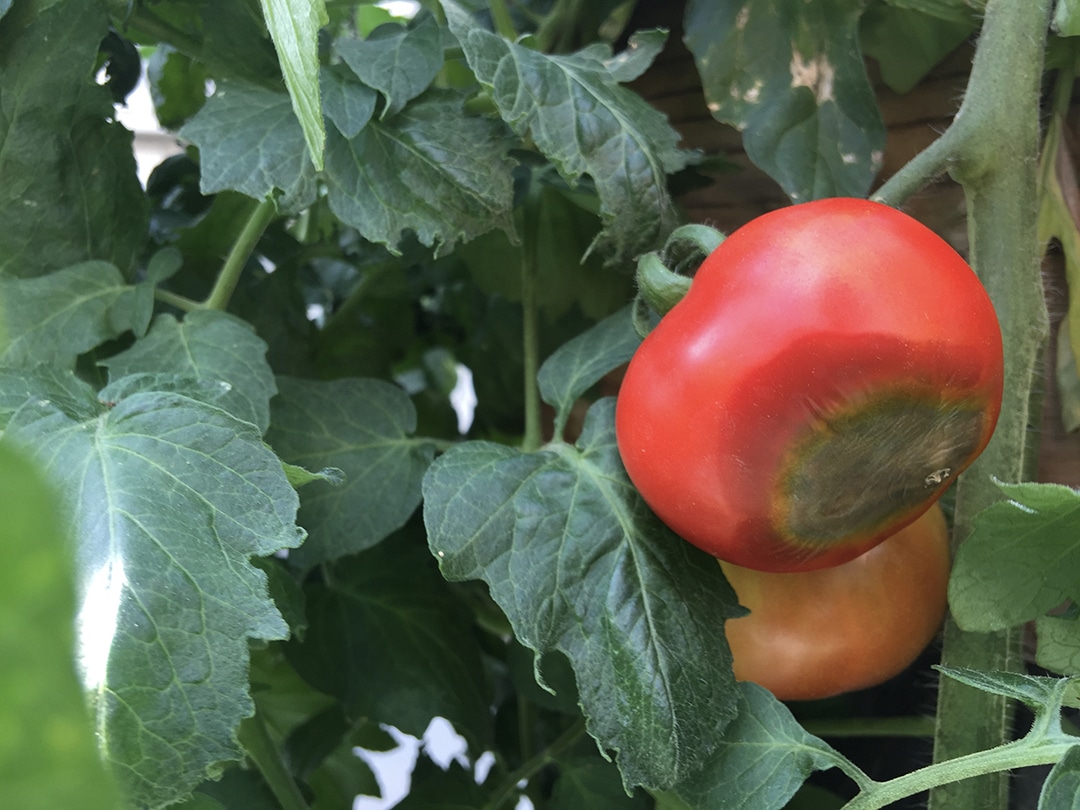
From Iowa State University Extension and Outreach
Tomatoes are popular vegetables in the home garden. Most gardeners currently are enjoying their harvests. However, tomatoes are susceptible to a range of disorders that can compromise their quality and yield. In this article, horticulturists with Iowa State University Extension and Outreach discuss what you can do when you encounter issues with your tomatoes.
Why are my tomatoes cracking?
Fruit cracking is a common issue in tomatoes, often appearing at the top or stem end of the fruit as cracks that radiate out from the stem or circle the stem in concentric rings. Fruit cracking is associated with wide fluctuations in soil moisture levels, such as heavy rain or deep watering after a dry spell, causing rapid water uptake and subsequent cracking. Large beefsteak-type tomatoes are particularly prone to this issue.
To prevent fruit cracking, maintain consistent soil moisture, especially during fruit development. This can be achieved by watering thoroughly once a week during dry periods and using mulch, such as dried grass clippings, straw and shredded leaves to conserve moisture. Additionally, for better results, choose crack-resistant varieties such as Jetstar, Mountain Spring or Mountain Fresh.
Several of my tomatoes are misshapen. Why?
Misshapen (catfaced) fruit may be due to cool weather during fruit set. Exposure to 2, 4-D or similar broadleaf herbicides can also cause misshapen fruit. Catfacing is most common on large-fruited tomato varieties. Affected fruit shows leathery scars, bulges or holes at the blossom end of the fruit. The incidence of catfacing is typically highest on the early maturing fruit and declines during the remainder of the growing season.
A blackish spot develops on the bottom of my tomato fruit. What is the problem and how can it be prevented?
Blossom end rot is the likely cause of the problem. This common problem on tomatoes appears as a brownish-black spot on the fruit’s blossom end (bottom). Secondary organisms invade and cause the fruit to rot. Blossom end rot is most common on the earliest maturing fruit that ripen in July and early August.
Blossom end rot is caused by a calcium deficiency in the developing fruit. Wide fluctuations in soil moisture levels impair calcium uptake by the root system of the tomato plant. Excessive nitrogen fertilization may also contribute to blossom end rot.
To prevent blossom end rot, provide consistent moisture to the plants. When dry, water tomatoes weekly with 1 to 1½ inches of water and mulch to maintain soil moisture. Avoid over-fertilization and remove affected fruit to help the plant focus on healthy fruit development. There is no need to apply calcium to the soil as most Iowa soils contain more than adequate calcium levels.
Blossom end rot can also occur on pepper, eggplant, summer squash and watermelon.
My tomatoes are developing white or yellow areas on the sides of the fruit exposed to the sun. Why?
Sunscald on tomatoes appears as white or yellow patches on fruit exposed to extreme heat. These areas eventually dry out, become sunken and can rot due to secondary infections.
Losses due to sunscald can be reduced by growing tomatoes in wire cages. Cage-grown tomato plants provide good foliage protection for the fruit. Also, control Septoria leaf spot and other foliar diseases, which defoliate the plants and expose the fruit to direct sunlight.
My tomato plants are wilting despite adequate rainfall. Why?
Wilting in tomato plants may be caused by Verticillium or Fusarium wilt, soilborne fungi that block water flow through the plant’s vascular system. Symptoms include daytime wilting with recovery overnight that worsens over time, yellowing foliage and eventual plant death. A cut through the lower stem of a dead plant often reveals a brownish discoloration of the vascular tissue.
Nothing can be done for plants that have Verticillium or Fusarium wilt. Plants that die should be removed and destroyed. Crop rotation is of limited value as the vascular wilt fungi may survive in the soil for several years. The best prevention is using resistant cultivars which are marked with V or F following the cultivar name.
Stalk borers are another possibility. Stalk borers are insects that bore into plant stems and can also cause wilting and death. They attack a wide variety of plants, including tomatoes and many weeds that surround the area. Stalk borers are purple and cream-striped caterpillars and are an early-season pest that moves from tall grassy weeds to plants in the garden. An individual stalk borer may go from one plant to another, damaging several plants. The adult is an inconspicuous grayish-brown moth.
Stalk borer-damaged plants may survive when given good care. They are best managed by removing plants that die and controlling tall weeds around the garden. Stalk borers are not easily controlled with insecticides.
